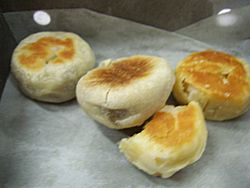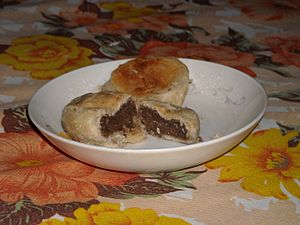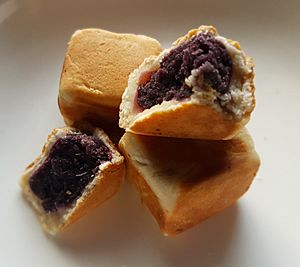Bakpia facts for kids
 |
|
| Alternative names | Hopia, Pia |
|---|---|
| Type | Pastry, sweet roll, kue |
| Course | Snack, dessert |
| Place of origin | Indonesia and Philippines |
| Region or state | Nationwide |
| Variations | Bakpia pathok |
Bakpia is a super popular sweet pastry. It's known as Bakpia (which means "meat pastry" in Chinese) in Indonesia. In the Philippines, it's called Hopia (meaning "good pastry").
This yummy treat is filled with beans. It looks a bit like a moon cake. People from Fujian, China, first brought it to these countries. This happened around the early 1900s. Bakpia is easy to find and doesn't cost much. It's often given as a gift to family and friends.
In Indonesia, it's also called bakpia pathok. This name comes from a place in Yogyakarta that makes a lot of these pastries. Bakpia are like smaller versions of another Indonesian pastry called pia.
Contents
Types of Bakpia Dough
Bakpia pastries come with different types of dough. These dough types give them unique textures.
Flaky Dough Bakpia

One type of bakpia has a flaky dough. This dough is similar to puff pastry. You can find this kind of bakpia in China, especially in Macau. It's also popular in Taiwan and places where many Chinese people live, like Trinidad and Tobago. Making this flaky crust needs a lot of skill.
Cake-Dough Bakpia
Another type of bakpia, especially in the Philippines, uses a soft, cake-like dough. This dough feels and tastes a bit like the wrapper of a fig newton cookie. This kind of bakpia is very similar to Japanese bean cakes. Because of this, it's sometimes called hopiang Hapon, which means "Japanese bean cake" in Filipino.
Delicious Bakpia Fillings
Bakpia pastries are known for their many tasty fillings. There are four traditional and most popular ones. But today, you can find many new and exciting flavors too! Some newer fillings include cappuccino, cheese, chocolate, custard, durian, mango, and pineapple. You can also find flavors like screwpine (pandan) and taro.
Mung Bean Filling
The most popular filling for flaky bakpia is mung bean. In Indonesia, it's called bakpia kacang hijau. In the Philippines, it's known as hopiang munggo. Sometimes, people call it hopiang matamís, which means "sweet hopia". This filling is a sweet paste made from split mung beans.
Pork Filling
Hopiang baboy means "pork hopia" in Filipino languages. This bakpia has a savory filling. It's made with breadcrumbs and small pieces of candied wintermelon. It's flavored with scallion and has candied pork fat, which gives it its name. This type of hopia is sometimes called hopiang maalat, meaning "salty hopia".
Purple Yam Filling
Ube hopia or hopiang ube is a special kind of hopia from the Philippines. It uses purple yam for its filling. Purple yam is called ube in Filipino. The filling tastes a lot like halayáng ube, which is a traditional Filipino jam. This jam is often eaten during the Christmas season. Like other ube dishes, it has a bright purple color and a sweet taste.
Gerry Chua first introduced Ube hopia in the 1980s. He owned Eng Bee Tin, a Chinese-Filipino food shop in Manila. This shop is famous for mixing Chinese and Filipino food traditions.
Azuki Bean Filling
Another type of hopia from the Philippines uses red azuki bean paste. This one is called hopiang hapón, meaning "Japanese hopia". It's different because it's made with cake dough. These pastries are small and round. They are similar to a Japanese sweet called kuri manjū in their filling and texture. This is why they are called "Japanese hopia". Sometimes, these are shaped into cubes and cooked on a griddle instead of being baked.
See also
 In Spanish: Jopia para niños
In Spanish: Jopia para niños



